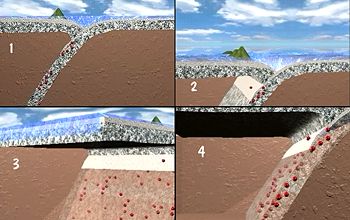The Richter scale was defined as a measurement of the amplitude of the P and S waves as measured on the seismograph. The seismograph should be located 100 km ( ~ 62 miles) from the epicenter. Since the waves have very large amplitudes the scale was made logarithmic.
Magnitude 1 = 1
Magnitude 2 = 10
Magnitude 3 = 100
Magnitude 4 = 1000
etc. etc.
This is the scale number reported when an earthquake happens. It relates the earthquake to other earthquakes. But... we might like to know what the energy release is as that is directly related to the final damage caused by the quake.
Earthquakes with a high number of long duration waves have about a 30 fold increase over the entire earthquake record. The difference in energy release between a Richter 4 and a Richter 7 is about 27,000 times (30x30x30)
An earthquake of about magnitude 8.6 release about the same energy as 10,000 Hiroshima bombs! The good news is that they tend not to me focused in a single moment at a very sort range.
1.) Ground Motion: waves travelling through the ground (especially regolith) can cause foundations to slip and buildings to topple.
2.) Direct movement of the fault. Anything that sits on the fault can be split in half, raised and lowered, or toppled.
3.) Fire: caused by the rupturing of gas mains or the release of natural gas. Also the rupture of the water mains means there is no water to put out the fires.
4.) Triggering landslides, or other mass wasting processes.
5.) Water saturated ground can be turned into a gelatinous material when shaken. This process is called liquefaction. Buildings can sink in the material and collapse.
6.) Creation of tsunami in the ocean. Fast travelling title waves.
A scale has been created to relate damage to the Richter scale. It is called the modified Mercalli Scale, an ranges from 1 to 12 (using roman numerals). Mercalli values of 10 and up relate to serious damage.
X (10) ---- Serious damage - some building collapse (Richter 7.0 -7.3)
XI (11) ---- Great Damage - most buildings collapse (Richter 7.4 - 7.9)
XII (12) ---- Total Destruction - waves seen on ground objects thrown (Richter >8.0)

1.) Subduction plate near ocean trench. (Gray/grainy is lithosphere)(Brownish larger areas are aesthenosphere.)
2.) Removed the left aesthenosphere so you can see more of the lithosphere plunging below.
3.) Made the plunging lithosphere more transparent and show the focal point of numerous earthquakes. (Red dots)
4.) Notice all of the Red Dots (earthquake focal points) lie within the lithosphere and most near the top. This is the Benioff Zone. If the earthquake focal points are plotted they basically define the lithospheres shape.
| NEXT | TOC | PREV |